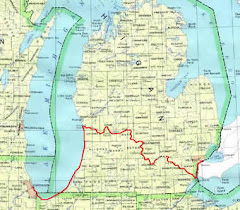I'm trying to put myself into Verlen's head when he was planning the Two Continent Expedition maybe 23 or 24 years ago. He would have known from his readings of the history of the French explorers that it was possible to travel by water from Montreal on the St. Lawrence to New Orleans on the Mississippi with but one eight mile long overland portage in what is now northeastern Indiana. That portage was across the low Continental Divide between the Atlantic drainage and the Gulf of Mexico drainage. Maybe he had learned the details of how to cross that portage from other canoeists but I'd like to think he worked it out on his own as I am trying to do. The key to this puzzle is how to get from a bend of the St. Mary's River in Fort Wayne to Little River, a headwaters tributary to the Wabash. There is no clue in the Newsletters as to how they did it. I never asked Verlen or Valerie how they handled portages on the the Two Continent trip. The Sea Winds were equipped with widely-admired portage yokes built into the seats but they weighed over 60# and I question whether Valerie had the heft to shoulder one. Maybe Verlen shuttled them. Perhaps I will learn more as I read more of the Newsletters. I know canoe wheels were available then because I used my Swedish-built rig with bicycle wheels to portage my 17' aluminum Grumman Eagle on Grand River Expedition '90. I haven't seen any photos of the Krugers' canoes showing wheels like there were photos of the Ultimate Hugh Heward Challengers from last spring. Coach Huff's folding bicycle rig (which I call "The Traveling Junk Yard") is obvious. Jon Holmes had a folding set of wheels lashed to the back of his sea kayak and Charlie's and Mark P's wheels are legendary by now. If any of you know how they did the portages perhaps you can share the information with us. Maybe for this one they just pulled out of the Maumee at Fort Wayne when they went home for Christmas and put into the Wabash at Huntington when they resumed the trip. From Wikipedia: "The Little River is a small stream in Allen and Huntington Counties in northeastern Indiana. A tributary of the Wabash River, it is sometimes called the 'Little Wabash', which may cause it to be confused with the Little Wabash of Illinois (I ran into that problem). The Little River follows the Wabash-Erie Channel or 'sluiceway', a remnant of the Maumee Torrent that drained ancient Glacial Lake Maumee at the end of the Wisconsin glaciation, and joins the Wabash just west of Huntington." Geographically that is similar to the lower Maple River and the Grand River beyond Muir. Those rivers occupy a wide channel cut by the Glacial Grand when it was a torrent draining meltwater from Lake Saginaw in front of the glacial lobe that was blocking the Lake Huron basin some 10,000 years ago. Verlen would have been working mostly from books, topographic maps and atlases. I am using mostly Google Maps and TerraServe on my computer, a great convenience and visually much more satisfying. The "sluiceway" is very obvious on topographic maps. Playing with the topo on TerraServe and the satellite imagery and "Terrain" on Google Maps one can imagine the path of the ancient portage beginning at the western bend of the St. Mary's River by Sweeney Park in Fort Wayne and following West Jefferson Avenue to Portage Boulevard which follows a northeast/southwest trending linear high ground along the west side of the sluiceway valley. This high ground or low ridge, which I think is on the continental divide, passes through the Fort Wayne Country Club. Going in the same direction along or parallel to a railroad you would come to a whistle stop called Aboite at the natural end of Little River. Little River is channelized and connects to drainage ditches today. The carry would have been about 8 miles. I am sure local historians have it all figured out. Little River meanders southwest and west maybe 13 or so miles and joins the Wabash just west of Huntington. Next: The Wabash River. |

Saturday, December 12, 2009
Following Verlen and Valerie-IV-The Wabash-Maumee Portage
Subscribe to:
Post Comments (Atom)

No comments:
Post a Comment